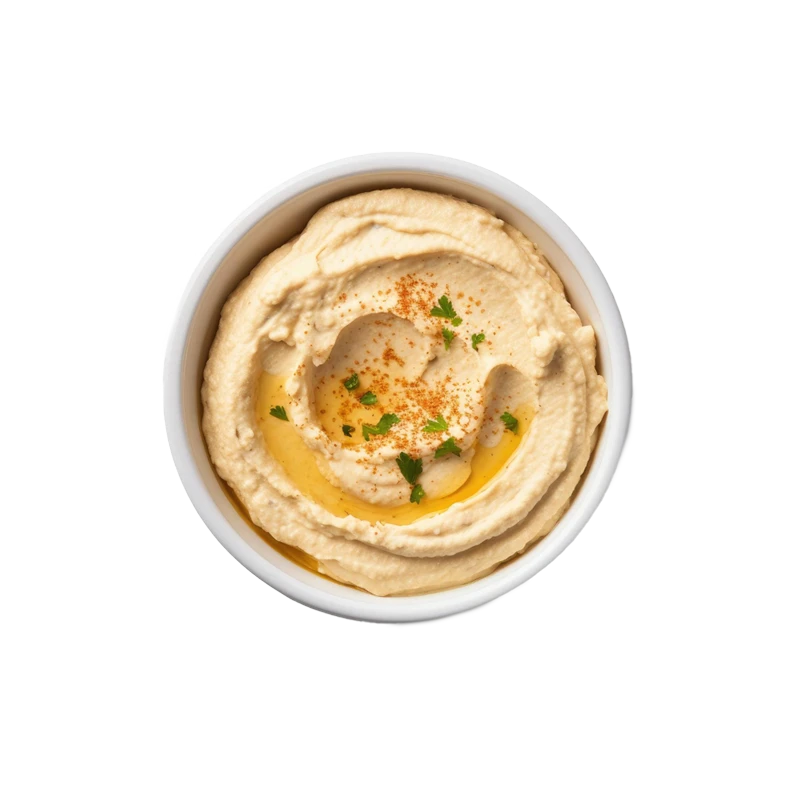Hummus — Nutrients, Health Benefits, And Shopping Tips

Written by Listonic Team
Last update on September 4, 2024
Nutrition facts
Nutrition facts
Amount per 100 g
Calories
🔥 166 kcal
| Nutrition per: 100 g | Value | % Daily Value* |
|---|---|---|
| Carbs | 14 g | 5.09% |
| Fiber | 6 g | 21.43% |
| Sugars | 0 g | - |
| Glycemic Index | 6 | - |
| Protein | 8 g | 16% |
| Sodium | 426 mg | 18.52% |
| Total Fat | 10 g | 12.82% |
*The % of Daily Value (DV) tells you how much a nutrient in a serving of food contributes to a daily diet. 2,000 calories a day is used for general nutrition advice.
6 g
🥔 Good Fiber Content
6
🟢 Low Glycemic Index
Did you know?
Health benefits
- High in protein from chickpeas and tahini, essential for muscle growth, repair, and overall body function.
- Rich in fiber, promoting digestive health, regular bowel movements, and a healthy gut microbiome.
- Contains healthy fats from olive oil and tahini, which support heart health and provide energy.
- Rich in essential vitamins and minerals such as iron, folate, Vitamin B6, and magnesium, which support overall health and well-being.
- Versatile and nutritious, making it a healthy addition to snacks and meals.
Health risks
- High fat content particularly in hummus made with significant amounts of tahini (sesame seed paste), which can contribute to increased calorie intake and potential weight gain if consumed in large amounts.
- High sodium content in some commercial hummus varieties, which can contribute to hypertension and increased cardiovascular risks.
- Potential for allergic reactions in individuals allergic to sesame seeds, chickpeas, or other ingredients commonly used in hummus, causing symptoms like itching, swelling, or difficulty breathing.
- Risk of contamination with harmful bacteria such as Salmonella or Listeria, particularly if the hummus is not properly stored or handled.
How to choose hummus
Hummus should be smooth and creamy, not gritty or too thick. It should have a pale beige color and a fresh, lemony scent. The texture should be rich and spreadable, ideal for dipping or spreading.
Stay away from hummus that is discolored or has a sour taste, signs that it is not fresh. Quality hummus should taste nutty and tangy, with a pleasant garlic flavor that is not too overpowering.

How to store hummus
Hummus should be stored in the refrigerator. Keep it in an airtight container to maintain its creamy texture and flavor. Properly stored, hummus remains fresh and delicious for snacking or meals.
Leaving hummus out for extended periods can cause it to spoil. It’s important to avoid exposing it to heat. Ensuring it remains cold preserves its taste and nutritional value, making it a healthy and tasty option.
✅ Extra Tip
How long do they last?
Hummus can last for 4-7 days in the refrigerator once opened. Always check for any signs of spoilage before consuming. For longer storage, hummus can be frozen for up to 4 months.
What to do with leftovers?
Leftover hummus can be used in a variety of creative ways. Spread it on sandwiches or wraps as a flavorful alternative to mayonnaise, or use it as a base for salad dressings by thinning it with olive oil and lemon juice. Hummus is also great as a topping for grilled meats or vegetables, where its creamy texture and tangy flavor add depth to the dish.
Use hummus as a filling for stuffed vegetables, like peppers or mushrooms, or mix it into a pasta sauce for a creamy, dairy-free option. If you have a lot of hummus, consider using it as a base for a hummus pizza, topped with fresh vegetables, olives, and feta cheese. Hummus can also be added to a grain bowl with quinoa or couscous, or served as a dip for pita chips, raw vegetables, or crackers. For a quick snack, spread hummus on toast and top with avocado, sliced tomatoes, or a sprinkle of seeds.
👨⚕️️ Medical disclaimer
Discover products from other categories
Listonic Team
Fact-checked
Our editorial team checked this article to make sure it was accurate at the time of publishing it.
Get the top-rated shopping list app

hummus
1 piece







